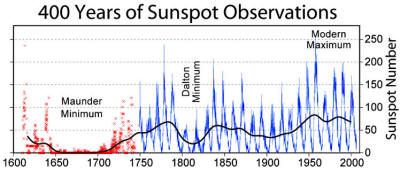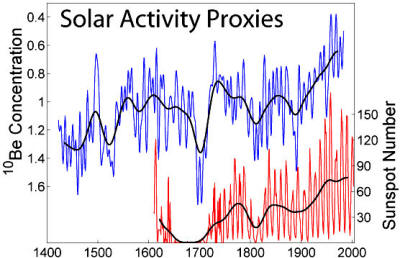|

by Michael Andrews
June 4, 2009
from
DailyTech Website
Report indicates solar cycle (below insert) has been
impacting Earth since the Industrial Revolution
Some researchers believe that the solar cycle influences global
climate changes. They attribute recent warming trends to cyclic
variation. Skeptics, though, argue that there's little hard evidence
of a solar hand in recent climate changes.
|
Experimental Link Found Between
Sun and Climate
by
Michael Asher
August 28, 2008
from
DailyTech Website
Evidence that solar variations impact both temperature
and rainfall.
The exact causes of climate change remain a mystery to
science. Many researchers link recent global warming to
changes in the sun. Others remain skeptical, claiming
that the sun varies only very slowly, over periods of
millions of years. They say that no hard evidence exists
for a solar effect on recent climate changes.
Now, new research may have provided just that evidence,
with data demonstrating that solar variations have had
major effects on the earth's climate as recent as 2,000
years ago. The research, conducted by a team of
scientists from the Universities of Ohio, Minnesota, and
Texas at Arlington, confirms that, during periods when
the earth received less solar radiation, the Atlantic
Ocean cooled, rainfall levels dropped, and North America
experienced periods of intense drought. Some droughts
lasted as long as a century.
Seven such events were detected, occurring once every
1,500 years, a period that matches the so-called "Bond
Events" cycle of solar variation.
According to the study's lead author, Greg Springer, the
correspondence provides "convincing evidence" of a solar
effect on North American climate. "This really nails
down the idea of solar influence on continental
drought," said Springer.
The critical data was obtained from an 8-inch long
stalagmite from a cave in West Virginia. As the
stalagmite grew over a period of several thousand years,
its composition precisely recorded fluctuations in the
Earth's climate.
Data more recent than 2,000 years ago wasn't examined,
as the authors feared the impact of Native Americans on
nearby watersheds may have influenced the results.
However, Springer tells DailyTech that analysis of river
discharges around the area confirm that the region is
still being impacted by such changes today.
The stalagmite was sampled at various points along its
length, each point radiologically dated to precisely
determine its age. Samples were analyzed to determine
the ratio of strontium to calcium, along with levels of
the isotopes carbon-13 and oxygen-18. Each of these acts
as a proxy (indicator) for various climate parameters
such as rainfall levels and land or sea-surface
temperatures. The stalagmite therefore acts as a highly
accurate record of climate variations over a period as
little as a few years.
Spectral analysis of the data revealed cycles with
periods corresponding to harmonics of the 1500-year Bond
Events, a cycle triggered by weak solar activity which
results in dramatic cooling and the occurrence of "IRD"
events -- ice raft debris forming in the Atlantic.
Springer tells DailyTech that the results "certainly
lends support" to global warming skeptics. However, he
himself is not sure that the recent level of variance is
enough to explain all the warming the Earth has
undergone in the past 100 years.
Last year, scientist S. Fred Singer published the book,
Unstoppable Global Warming (Every 1500 years), which
tied current warming to an ongoing Bond Event. Singer
tells Daily Tech that this new study provides further
evidence for a 1500-year Climate cycle, the evidence for
which was first discovered in ice core data.
The research is appearing in an upcoming edition of
Geophysical Research Letters. |
Now, a
new research report from a
surprising source may help to lay this skepticism to rest.
A study from NASA’s Goddard Space
Flight Center in Greenbelt, Maryland looking at climate data
over the past century has concluded that solar variation has made a
significant impact on the Earth's climate. The report concludes that
evidence for climate changes based on solar radiation can be traced
back as far as the Industrial Revolution.
Past research has shown that the sun goes through eleven year
cycles. At the cycle's peak, solar activity occurring near sunspots
is particularly intense, basking the Earth in solar heat.
According to Robert Cahalan, a
climatologist at the Goddard Space Flight Center,
"Right now, we are in between major
ice ages, in a period that has been called the Holocene."
Thomas Woods, solar scientist at the
University of Colorado in Boulder concludes,
"The fluctuations in the solar cycle
impacts Earth's global temperature by about 0.1 degree Celsius,
slightly hotter during solar maximum and cooler during solar
minimum. The sun is currently at its minimum, and the next solar
maximum is expected in 2012."
According to the study, during periods
of solar quiet, 1,361 watts per square meter of solar energy reaches
Earth's outermost atmosphere. Periods of more intense activity
brought 1.4 watts per square meter (0.1 percent) more energy.
While the NASA study acknowledged the sun's influence on warming and
cooling patterns, it then went badly off the tracks. Ignoring its
own evidence, it returned to an argument that man had replaced the
sun as the cause current warming patterns. Like many studies, this
conclusion was based less on hard data and more on questionable
correlations and inaccurate modeling techniques.
The inconvertible fact, here is that even NASA's own study
acknowledges that solar variation has caused climate change in the
past.
And even the study's members, mostly
ardent supports of AGW (anthropogenic global warming) theory, acknowledge that the sun may play a
significant role in future climate changes.
400 Years of Sunspot
Observations
Past studies have shown that sunspot
numbers correspond to warming or cooling trends. The twentieth
century has featured heightened activity, indicating a warming
trend.

Solar activity has shown a major spike
in the twentieth century, corresponding to global warming. This
cyclic variation was acknowledged by a recent NASA study,
which reviewed a great deal of past climate data.

NASA Study Shows Sun Responsible for
Planet Warming
by Bob Ellis
June 5, 2009
from
DakotaVoice Website
From DailyTech, we have still more evidence that any warming
occurring on planet earth is coming from natural sources and is
cyclic in nature - NOT from the evil capitalism that
Al Gore,
the
UN politicians at the
IPCC (Intergovernmental Panel on
Climate Change) and other socialists love to blame.
From the article:
Now, a new research report from a
surprising source may help to lay this skepticism to rest. A
study from NASA’s
Goddard Space Flight Center in Greenbelt,
Maryland looking at climate data over the past century has
concluded that solar variation has made a significant impact on
the Earth’s climate.
The report concludes that evidence for
climate changes based on solar radiation can be traced back as
far as the Industrial Revolution.
Past research has shown that the sun goes through eleven year
cycles. At the cycle’s peak, solar activity occurring near
sunspots is particularly intense, basking the Earth in solar
heat.
According to Robert Cahalan,
a climatologist at the Goddard Space Flight Center,
“Right now, we are in between
major ice ages, in a period that has been called the
Holocene.”
If our media, culture and a large
portion of the “scientific” community were really honest, it would
be the
worshippers of the religion of anthropogenic
global warming who are called “skeptics,” wouldn’t it?
Because it is those pushing this silly theory that our puny SUVs and
power plants are causing earth to warm up when the most obvious
source of heat hangs over their head every single day.
AGW simply doesn’t pass the smell test. Nor does it line up with the
objective data.
As this graph shows, solar activity has been cyclic in nature going
back hundreds of years.

Solar activity is also increasing, and
we are coming out of the “Little Ice Age” of just a few hundred
years ago.
Of course the planet is warming – we’re coming out of a
cold spell! The
Maunder Minimum period of diminished solar activity
coincided with the Little Ice Age when Europe and North America
experienced bitterly cold winters.
About 1,000 years ago, Greenland was warm enough (below
video) for the Vikings to colonize and grow vineyards. Today
Greenland is almost entirely covered in ice.
Tell me:
-
Is the earth
warmer today than it was 1,000 years ago?
-
Did they have SUVs and
coal power plants in the days of the Vikings?
This isn’t tough to figure out, people.
Unstoppable Solar Cycles
The Real Story of
Greenland
The only thing tough about the global warming debate is trying to
get the facts to match the socialist agenda of the AGW proponents.
Try as they might, they just can’t do it, and more and more people
are starting to see that.
Things like cyclic solar data,
warming occurring on other planets
such as Mars and Jupiter just don’t line up with the suppositions of
the AGW worshippers.
They craft all manner of complex
calculations and “what ifs,” but in the end the best they can do is
say things like,
“Well, we can’t prove it now, but by
the time we can, it’ll be too late.”
And we’re supposed to watch our electric
bills go up 40% and see our economy devastated on what-ifs and a
bunch of garbage that not only doesn’t match the evidence but
doesn’t even pass the smell test?
I’m not as gullible as these shysters seem to think I am, and I
don’t believe most of the American people are either.
|


